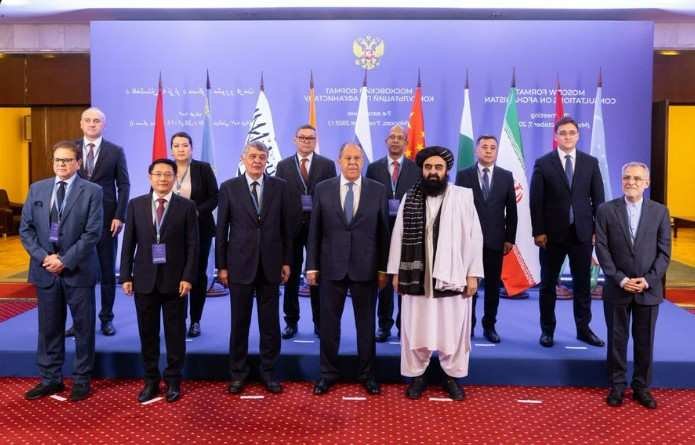India’s diplomatic machinery finds itself navigating a delicate symbolic minefield as Amir Khan Muttaqi, Foreign Minister of the Taliban-ruled Afghanistan, visits New Delhi for the first time since the Taliban regained control in 2021. While his six-day stay—enabled by a temporary travel waiver granted by the UN Security Council under Resolution 1988—marks a milestone in bilateral engagement, it also raises thorny questions about protocol, recognition, and diplomatic optics.
The Visit and Its Context
Muttaqi’s arrival in India between October 9 and 16 follows months of back-channel diplomacy, gradual humanitarian assistance from New Delhi, and prior contacts, including phone conversations and meetings held in neutral locations. India has not formally recognised the Taliban government in Kabul, but has maintained a ‘technical mission’ there since mid-2022 to facilitate trade, medical aid, and other humanitarian engagement.
He is expected to meet Foreign Affairs Minister S. Jaishankar and National Security Adviser Ajit Doval, among other senior officials. Topics likely on the table include counter-terrorism, regional security, consular services, infrastructure, trade routes, and humanitarian needs. Amid these discussions, India is emphasising its red line: that Afghan territory must not be used for terrorist activity against other countries.
The Flag Dilemma: Protocol Meets Principle
One of the most visible practical dilemmas of this visit concerns the display of flags during official meetings. Under standard diplomatic protocol, the flag of the host country is placed alongside the flag of the visiting country in photo opportunities or meetings.
However, since New Delhi does not recognise the Taliban’s governance (and therefore does not officially recognise the Taliban’s flag), Indian officials are debating whether to allow the Taliban flag to be displayed next to the Indian flag.At the Afghan embassy in New Delhi, the old flag of the Islamic Republic (the tricolour with emblem, used under President Ashraf Ghani) continues to fly. The Taliban flag—a plain white cloth bearing the shahada (Islamic declaration of faith) in black—is not shown.
At the Afghan embassy in New Delhi, the old flag of the Islamic Republic (the tricolour with emblem, used under President Ashraf Ghani) continues to fly. The Taliban flag—a plain white cloth bearing the shahada (Islamic declaration of faith) in black—is not shown.
India’s Position: Cautious Engagement without Recognition
New Delhi’s approach can be characterised as pragmatic diplomacy: it is engaging with the Taliban government on humanitarian, security, and regional stability issues, but it remains firm in its refusal to extend formal recognition unless there is evidence of an inclusive government and respect for international norms.
The travel waiver granted under the UN framework does not imply recognition; rather, it allows specific engagements under sanctions rules. Officials are keen to ensure that India’s actions do not amount to de jure recognition of the regime, even while de facto contacts increase.
India rolls out the red carpet for Taliban Foreign Minister Mawlawi Amir Khan Muttaqi in New Delhi.
The same Taliban that Indian media demonized for years, and right-wing trolls mocked for being “Muslim extremists.”
Now suddenly, diplomacy replaces disgust, because politics has… pic.twitter.com/W9JCHYIEY0
— Muslim IT Cell (@Muslim_ITCell) October 9, 2025
Likely Outcomes and Significance
How India resolves the flag question will send broader signals—internally to its polity, and externally to other regional powers and to the Taliban regime itself. Possible outcomes include:
-
Opting not to display the Taliban flag in any setting, thereby maintaining its non-recognition stance, but running the risk of diplomatic awkwardness.
-
Allowing the flag only in less formal settings or in a limited manner, perhaps with clear disclaimers or symbolic adjustments.
-
Using the tricolour of the former republic at the embassy and in official Indian settings, while declining the Taliban flag in meetings, to ensure consistency with past policy.
Beyond the symbolism, the visit could pave the way for more stable channels for humanitarian assistance, clearer demarcation of counter-terrorism expectations, and potentially more trade or connectivity if security and governance conditions improve.
Conclusion
Amir Khan Muttaqi’s visit to Delhi represents something of a diplomatic tightrope for India: balancing humanitarian and regional imperatives against principles of recognition, legal obligations under UN sanctions, and domestic political sensitivities. While the flag question may seem small, it encapsulates the larger tension between engaging with an existing power structure for strategic and humanitarian reasons, and maintaining international norms and India’s own policy positions. The resolution New Delhi chooses will likely be read as a barometer of how far it is willing to go toward normalization—and how it handles symbolism in diplomacy when principle and pragmatism clash.








